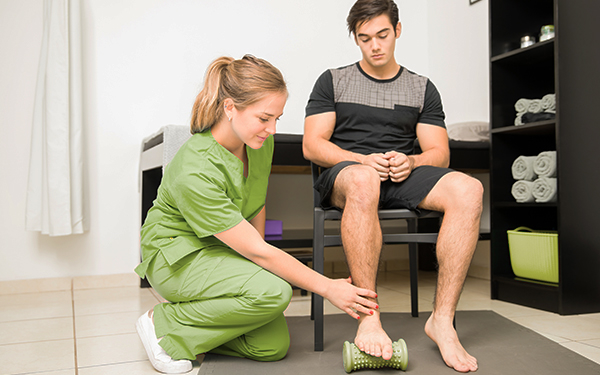Plantar Fasciitis
Plantar fasciitis affects approximately 2 million Americans each year and is the number one cause of heel pain. Plantar fasciitis can affect anyone, but it most often appears in those who are often on their feet, those who wear improper shoes, or those who are overweight.
The condition results from the inward rolling (over-pronation) of the foot and ankle which in turn causes increased weight over the medial arch of the foot. When the arch is stressed from increased weight, the connective tissue on the bottom of the foot (referred to as the plantar fascia) becomes stretched and eventually causes the development of painful scar tissue.
Symptoms & Diagnosis
Many patients with plantar fasciitis will also have bunions, calluses, and/or heel spurs on the affected foot. Usually, plantar fasciitis pain is most severe with the first few steps of the day after awakening. It is a good idea to periodically check the wear patterns on the bottoms of your shoes. With uneven wear patterns, improper biomechanics are quickly implicated. Also, try flexing your toes back towards you while observing the bottom of your foot. If the fascia seems taught and band-like or if there are tender nodules in the soft tissue on the bottom of your foot, it is a good indication that plantar fasciitis is developing.
Medical Treatment
Although medications do not treat the underlying problem, NSAIDs and corticosteroids are often used to ease the pain and inflammation associated with plantar fasciitis. However, these medications are stressful to the rest of your body and come with a list of possible side effects. Furthermore, multiple injections of corticosteroids can actually weaken the plantar fascia, rupture it, or cause the fat pad covering the heel to shrink.
Another medical treatment option is extracorporeal shock wave therapy, which uses sound waves to stimulate healing. This treatment is usually only utilized on plantar fasciitis cases that have not responded to conservative treatment, and it may cause swelling, bruises, numbness, pain, or persistent tingling. More importantly, it is not always effective at eliminating plantar fasciitis.
When symptoms are severe and other treatment options have failed, surgery may then be recommended to treat plantar fasciitis. Side effects of plantar fasciitis surgery include weakening of the arch of the foot, risk of nerve damage, infection, and eventual rupture of the plantar fascia. Furthermore, like other medical treatment options, there are times when surgery fails to improve the pain associated with plantar fasciitis.

With conservative treatment, over 90% of people affected by plantar fasciitis could have a full recovery in less than one year. At Divine Design Natural Health, our solution for plantar fasciitis has immediate results and is successful in eliminating most cases of plantar fasciitis in approximately three visits; however, it can be very painful. The level of pain depends greatly upon the severity of the plantar fasciitis as well as your personal pain tolerance. Some patients do not complain of pain at all during treatment, but we would rather warn you of the potential rather than surprise you afterwards.
Our plantar fasciitis treatment consists of specific ankle and foot adjustments and intense soft tissue work to break up the adhesions in your arch. Detoxification and cold laser therapy are likewise involved. You will be given specific at-home exercises to perform for a few minutes each day in order to shorten healing time. As with any condition, Divine Design Natural Health addresses the underlying cause of the problem. Therefore, patients will often require nutritional supplementation and dietary modifications to lose weight and thereby decrease future stress upon the plantar arch.



